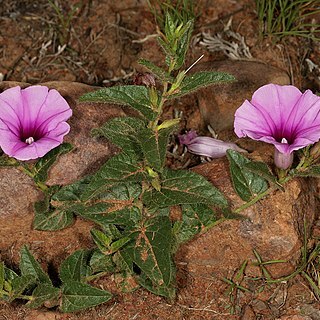Perennial herb; stems long or short, suberect or prostrate, pilose.. Leaf-blade triangular, oblong or exactly ovate, 1.5–6 cm. long, 1–5.2 cm. wide, obtuse, acute or acuminate at the apex, emarginate or cordate at the base, densely pilose with rather long silvery hairs on both surfaces; petiole 0.3–3.5 cm. long.. Flowers solitary or in 2-flowered cymes; peduncle 1.5–4 cm. long; pedicels 6–18 mm. long.. Sepals oblong or lanceolate with hyaline edges, 7–8 mm. long, 2.5–3 mm. wide, pilose.. Corolla magenta, pink or white with purple centre, funnel-shaped, 3.7–4.5 cm. long; flower-bud with small but highly characteristic tuft of white hairs at the apex which become 5 small inconspicuous tufts in the open corolla which is otherwise glabrous.
Suberect or prostrate perennial herb. Leaves triangular, oblong or ovate, densely pilose with long silvery hairs; obtuse, acute or acuminate at apex; emarginate or cordate at base, entire. Sepals oblong or lanceolate, acute, thinly and softly hairy outside. Corolla 35-55 mm long. Flowers magenta, pink or white with purple centre.
A climbing herb. It can grow 2-3 m long. It has annual stems from a long tuber. The leaf blade can be triangle shaped or oval. They are 2-8 cm long by 105 cm wide. The flowers occur singly or in groups or 2. They are funnel shaped and 4-6 cm long.
Corolla funnel-shaped, magenta, pink or white with purple centre, 3·5–5·5 cm. long; flower-bud with small but highly characteristic tuft of white hairs at the apex which become 5 small tufts in the open corolla which is otherwise glabrous.
Leaf lamina triangular, oblong or ovate, 1·5–8 × 1–4·5 cm.; obtuse, acute or acuminate at the apex, emarginate or cordate at the base, entire, densely pilose with rather long silvery hairs on both surfaces; petiole 0·3–3·5 cm. long.
Flowers solitary or in 2-flowered cymes; peduncles 1·5–6·5 cm., hairy; pedicels 6–15 mm. long, thickened upwards, less hairy than the peduncles; bracts minute, lanceolate.
Sepals subequal, herbaceous, oblong or lanceolate with hyaline edges, 7–8 mm. long, acute, usually thinly and softly hairy outside.
Perennial herb forming annual stems from a long fusiform tuberous rootstock.
Stems suberect or prostrate up to 1 m. long, pilose.
Capsule subglobose or somewhat ovoid, glabrous.
Seeds densely and shortly velutinous.

